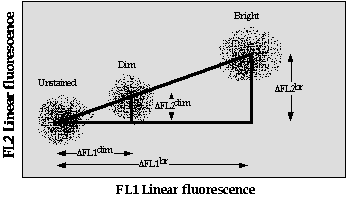
(Go back one page to autofluorescence, or
back to the introduction)
Proper compensation requires that the median fluorescence of the stained
population in every other channel (other than the channel specific for the
stain) is equal to the median fluorescence of an unstained population, in
those same channels. For a discussion of this, you can visit the page on
practical compensation (there will be no direct
way to navigate back to this page).
In general, then, you should use the brightest reagent possible for each
compensation. Proper compensation of a bright reagent guarantees than any
dimmer reagent will also be properly compensated. The converse, while true
in an ideal world, is not true practically. This is because the error in
estimating the required compensation will be much larger when compensating
on a dim population (i.e., the amount of fluorescence that is spilling into
a second channel, usually a small fraction of the main fluorescent signal,
becomes very difficult to quantitate accurately). Thus, small errors in
the compensation value can lead to large errors on very bright populations.

This graph shows three populations of cells stained with only fluorescein:
the negatives, a dim population, and a bright population. This graph is
shown for linear fluorescences to illustrate the principle--but holds true
for logarithmic fluorescence collection. The proper compensation value is
the ratio of the delta-FL2 signal to the delta-FL1 (for the dim or bright
cells). This ratio, ideally, will be measured to be the same whether bright
or dim cells are used. However, measuring the delta-FL1 and delta-FL2 values
for the dim cells will have inherently greater error that for the bright
cells, and therefore the calculated ratio (compensation value) will be prone
to much greater error.
This graph also shows why it is necessary to have a positive and a negative
population to properly set the compensation: it is the ratio of the differences
in the fluorescences between these two populations that is critical for
defining the compensation. (Strictly speaking, a negative population
is not necessary--only that two different levels of staining are present.
Thus, in the graph above, proper compensation could be set by using only
the dim and the bright cells. Mathematically, the ratio of the differences
between FL2 and FL1 for each pair of populations above are identical--there
is nothing special about a negative population that lends it to calculating
compensation.)
Incidentally, this shows why it is important to have the same autofluorescence
for the negative and positive populations: otherwise, the delta-fluorescences
will be due not only to the stain, but to differences in autofluorescence
between the cell types--resulting in incorrect compensation values.
Go on to co-stained compensation samples.